
Shakespeare, Sonnet 18 Written between 1593 and 1601, published in 1609.


Brexit Photo: © 2017 MHP
When men come to be undeceived, it is too late; the jest is over, and the tale hath had its effect….like a physician, who hath found out an infallible medicine, after the patient is dead. Jonathan Swift.
“Mrs May condemns Catalonian nationalists for ‘a reckless act of separatism’ that ‘risks casting their people into a wholly unnecessary calamity‘.”
(BBC website, with thanks to Christopher Oxford for his invaluable FB page which represents the rational resistance to Brexit.)
“To know thyself is the beginning of wisdom.” Socrates
“There are few, very few, that will own themselves in a mistake.” Jonathan Swift
“You should never be ashamed to admit you have been wrong. It only proves you are wiser today than yesterday.” Jonathan Swift
“It is the right of those of us who voted to remain to continue to speak for what we believe is in our country’s best interest and not allow ourselves to be cowed into silence.” Ian McEwan

Truth Unacknowledged bronze sculpture by Paul Dalou (1838-1902). Image: WGA
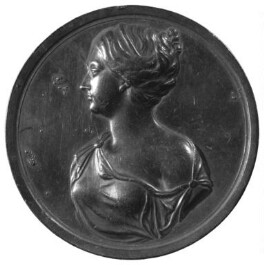
Silver medal, 19th century, based on a work of circa 1667 © NPG
Frances Stewart, chosen for her impeccable Roman profile, was depicted on two commemorative medals celebrating rare English victories during the Anglo-Dutch naval wars.
Pepys, who checked out all King Charles II‘s mistresses in detail, like a creepy judge at a beauty contest, thought the young Frances Stewart was the best-looking of the lot. She was a celebrity in France, too, where the bitchy Comte de Gramont said “it would be difficult to image less brain combined with more beauty”.
Like Maria Gunning a century later, she must have got used to being called beautiful and stupid. Maybe Frances was shrewd enough to play dumb, like Lorelei Lee, who knew how “to be smart when it’s important”, because she managed her life and her money more sensibly than most of her wittier, cleverer contemporaries.
Court observers suspected her of coquetry while playing the long game of becoming queen if the king’s wife died. As with most royal mistresses, there was a political faction pushing and grooming her, just as there are agents and casting directors and publicists promoting a starlet.
Frances, the socially ambitious daughter of a very minor courtier, distantly related to the royal Stuarts, had been talent-scouted at the French court, where she had been trained in flirtation, a more useful education than most pretty, vapid upper-class English girls of the Restoration were likely to get.
Unlike their Tudor ancestresses, Restoration girls were brought up in ignorance. The great feminist writer of the late 17th century, Mary Astell, denounced the education given girls as useful only “to make a fine show and be good for nothing.” She asked the rest of her sex, “How can you be content to be in the World like Tulips in a Garden?”
Frances excelled at all the things that made a fine show – dancing, playing, fashion and flirting – and her apparently empty head kept her safe from controversy. Clever men and women look down on apparently stupid girls like Frances unwisely.
If you were very good at flirting, you could use it for protection as well as promotion. It actually was good for something, like being good at politics.
And Frances, once she realized she was never going to be a queen, was playing a much longer game than the spiteful gossips guessed.
She married her duke, also a Stuart, when she was nineteen, was widowed at twenty-five and never married again. For the rest of her life as a Tulip she enjoyed high social status, wealth and prestige and, by not re-marrying, a rare degree of independence. She was adept at financial and estate management. She did not have children. She was a virgin again.
Maybe she didn’t enjoy sex. Maybe she disliked, or feared, physical intimacy. Maybe she wanted autonomy. After the frenetic sexual hide and seek, the flattering attentions and unwanted harassment of her teens, she won her freedom from patriarchal control.
She and the king were reconciled after her marriage and remained friends till his death, which was the happiest ending for the debonair predator and the chaste huntress.

Frances Teresa Stuart, Duchess of Richmond and Lennox
by Willem Wissing and Jan van der Vaart
oil on canvas, 1687. © NPG
Frances, painted two years after Charles II’s death, aged 40, dressed in her Duchess’s state robes, resting her elbow next to her coronet. She was long since free of the Duke, her husband, and enjoying all the advantages of her position.
Late 17th century court portraiture elongated the female figure, but Frances was tall in person, too. She was 5’8″. Queen Mary II (1662 – 94) was 5’11”, the same height as her great-great grandmother, Mary, Queen of Scots. It’s a myth that everyone in history was shorter than us. In the 1690s there was a movement, encouraged by Mary, against libertinism which attempted to eradicate the worst obscenities in social behaviour. The new seriousness was reflected in the subdued colouring and
sedate poses of their portraits.
The gift of beauty that Frances was granted is misunderstood by envious people. Psyche’s trials and tribulations were mostly caused by jealous women, including her own mother-in-law, Venus.
Beauty gives more joy to the beholder than to the owner who has the lifelong task of looking after it. Before inoculation was introduced in the 1720s being a beautiful female mortal was doubly hazardous because even if you were lucky enough to survive childbirth, you could so easily lose your looks or your life to smallpox.
La Belle Stuart was scarred by the disease in 1668, when she was only twenty, but she survived to be fifty-five, still small-waisted and elegantly proportioned, her face still distinguished by her sweet smile and her perfect little Roman nose, commemorated by her life-size wax funeral effigy, dressed in a duchess’s coronation robes, that stands in the vault of Westminster Abbey.
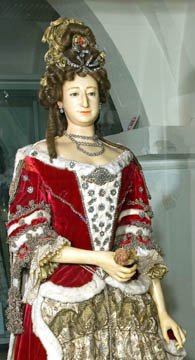 Image copyright Westminster Abbey
Image copyright Westminster Abbey
The memorial was her own idea. The other effigies of kings and queens around her look stiff and stolid, their faces tired and blank, as if they can’t bear the thought of another performance. Waxy, painted, corseted elderly Frances, false hair curled and piled high in a fontange, looks vibrant, walking towards her audience with the sprightly step of Diana the Huntress, with wide open eyes and that charming smile.
This is the fame she always wanted, with a title and the royal Stuart name, and no-one to touch her.
She is accompanied by a stuffed grey African parrot, who had been her constant companion in life for forty years. Together they make the most touching tableau among all the eerie monuments of the Stuart Age.
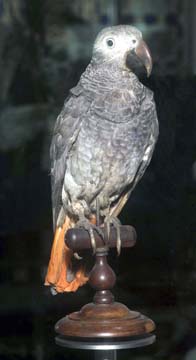 Image copyright Westminster Abbey
Image copyright Westminster Abbey
After the Restoration of the Stuart Monarchy, the fashionable ruling class no longer wanted to be portrayed in an elevated spiritual sphere where they knew they didn’t belong. The reward they claimed for going to hell and back was instant gratification, not introspection. Some of them were still secretly very religious, but knowing how short and brutal life could be, waited till their deathbeds for their conversions.
They had lived through Civil War and exile, and they didn’t want to look other-worldly like the previous generation. Nothing was sacred, except survival. A new generation of court painter was happy to oblige with contemporary takes on traditional allegory in a flashier, worldly-wise presentation. The studied nonchalance of Van Dyck’s figures, inspired by Castiglione’s The Book of the Courtier, crumpled into the straight out of bed look.
On the great consensual casting couch of the Restoration Court, Charles II‘s mistresses competed to make him laugh as much as get into his bed, and one of Lady Castlemaine’s jokes was to have herself painted as the Virgin Mary with her eldest bastard son by the king playing baby Jesus.

Barbara Palmer (née Villiers), Duchess of Cleveland with her son, Charles FitzRoy, as the Virgin and Child
by Sir Peter Lely, c. 1664. National Portrait Gallery. Image: Wikipedia
Like a modern supermodel, but without make-up, she set the look of the day. Lely used her sensuous features, the heavy-lidded eyes and full lips, as the template for all his portraits of high society beauties, so there were complaints (from Pepys, for instance, and Rochester when he saw the portrait of his wife) that nobody else looked anything like themselves.
She was a sex-addict with a terrible temper and a gambling addiction. Today, she’d be diagnosed with a personality disorder. If she was a man, we’d be terrified of her, and prosecute her for harassment. Instead, we find her entertaining, titillating, challenging, ultimately pathetic.
Barbara is famous for being the most promiscuous, and unfaithful, of Charles II‘s mistresses, portrayed as the nymphomaniac Fuckadilla in a contemporary pornographic satire. Her list of lovers, including Jacob Hall the tight-rope dancer, John Churchill, later Duke of Marlborough, England’s most victorious general, and the playwright William Wycherley, shows she picked talent. She also paid them generously.
She was a life-force, and could be great fun. She enjoyed the thrill of power, or its illusion, and exerting political influence whenever she could, but for purely selfish reasons, to settle personal scores. She acted from the heart, not the head. She was unsentimental, and sometimes compassionate, an important distinction that we have lost sight of.
She was shocking to the country outside the King’s circle, the incarnation of the immorality and waste at Court, a curse on the country, a scapegoat for all the frustration and disappointment with the restored monarchy.
She was politically useful, that way.
She was not popular, like the People’s Choice among the King’s Ladies, Nell Gwyn; she was the Bad Girl, the Dirty Girl, the Bunny Boiler, the Alien Succubus, the space vampire played by Mathilda May in Lifeforce; she was X-rated, HBO, not terrestrial TV.
She was culturally essential, that way.

Barbara Palmer (née Villiers) as The Penitent Magdalene by Sir Peter Lely.
Image: Wikipedia
There was one gender injustice she could not defy, the plight of the older but still sexual woman. Barbara was forty-five when her protector, the King, died, and everything started going wrong. She got desperate and stopped discriminating. The once gorgeous predator became the prey of bad actors and con-men. She made a disastrous second marriage when she was sixty-five to a bigamist who was after her money.
The last years of her life read like the moralists’ revenge. It is documented in the DNB that in her final illness a dropsy “swelled her gradually to a monstrous bulk”, exactly the kind of private detail about our own or our beloveds’ deaths that we would want kept quiet.
There is a very sad ghost story about Barbara, Duchess of Cleveland as an old woman lamenting her lost beauty as she walks in her high heeled shoes tapping on the wood floor to stare out of the windows of her house on Chiswick Mall.
Good plastic surgery might have prevented that.
The woman while she lived was not penitent. She seized her moment, enjoying the sexual, and bi-sexual, liberation of the Restoration Court as much as any man. Her appetites, or addictions, and her temperament were entirely suited to her time.
The female libertine did not see herself as objectified or victimized, and we should not judge her differently.

Peter Paul Rubens, Annunciation, c. 1628 Oil on canvas, Rubens House, Antwerp.
Image: WGA
It is the same astonishing moment as a thousand times before and after – the same winged and muscular messenger, with the same soft feminine face, the same long golden hair, wearing a yellow tunic, accompanied by a dove and flying babies, interrupting a girl reading while a cat sleeps in the corner – but in a different place, light years away.
This is no baby shower, like the time before. This time the stranger does not bring the pure white flowers of virginity to present to the girl from a deferential distance. There are already flowers in a bulbous glass vase on a round table; red and pink roses unfurling petals the colour of flesh, a red tulip protruding a licking tongue. The dive-bombing cherubs are about to pelt garlands of more roses, a lover’s gift, on the girl’s head.
It’s not the same girl, or she has changed. She reads the same book, but she is not self-composed like the girl kneeling in a room in Urbino, over twenty years earlier. There is no view of a white castle, the room is dark and the floor is made of wooden nailed planks.
There is no sign of the patriarchal puppeteer in the sky. There is no formality, no inhibition, only the visitor’s knowing smile as he alights, his left hand almost close enough to touch her, and her gasp of expectation. Even the watching cherubs are louche.
This time she is aroused by the visitor’s physical presence and does not attempt to hide her feelings. Illuminated by a beam of light, she rises to meet his passion with her own, her lips parted and her uplifted eyes rolling in ecstasy. She is almost drifting into a trance. Her longing for him is mixed with reproach. She is worried about consequences.
She is Psyche in love with Eros, who has flown in through her open window at night. He is beautiful and persuasive. His power will change her life.
She is not sure she wants him yet.
(Keats, Ode to Psyche, 1819)
It’s not the same cat, either. This one is a tabby, coiled tight in its own sensual world, indifferent to human desires, lying on the hard wooden floor beside a work basket because the girl has forgotten for the first time in their lives to make a cushioned bed for its sleep.
 Federico Fiori Barocci, Annunciation
Federico Fiori Barocci, Annunciation
1592-96 Oil on canvas, Santa Maria degli Angeli, Perugia. Image: WGA
A cat sleeps on a cushion in the corner of a room while a fourteen year-old virgin receives her pregnancy results from a beautiful, transgender visitor, who presents Madonna lilies as a baby shower gift. The girl smiles sweetly, and lowers her eyes modestly. She is grateful but not surprised. She accepts the news in the composed manner of a young prima donna receiving the bouquet that her talent deserves.
The visitor has only just arrived, interrupting the girl reading a small, pocket-sized book, which she lays aside instantly, without closing the pages or rising to her feet. The girl reads a lot. She has few possessions apart from her expensively bound books. She reveres their contents, kneeling while she reads. Her room is sparsely furnished, functional; only the voluptuous folds of the dark red drape loosely knotted over the window relieve the cell-like austerity. She cares about the cat’s comfort as much as her own. She has hung her hat and shawl neatly on a hook. The polished stone tiled floor is clean.
Nothing else is normal, and yet the scene is familiar. The visitor, who kneels before the girl as if she is a queen, has wings, and is accompanied by two over-excited flying babies, clapping their hands and gurgling with joy on either side of a hovering dove. The window drape looks like a stage curtain, framing a view of a white turreted castle on a hill, guarding a city beyond, a landscape in fairyland.
Strangest of all, the ceiling has been removed from the room. The billowing curtain blends into clouds that separate to allow a gigantic elderly man with a long beard to peer down out of a hole in the sky. Golden light radiates behind him, crowded with faces of more chubby babies, made of the Sun, all pressing closer and closer to the girl in the room. He holds his hands palms down over the girl like a puppeteer pulling invisible strings.
The cat sleeps.
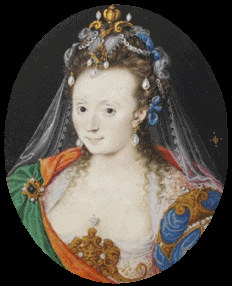 Unknown woman in masque costume, miniature by Isaac Oliver, 1609. Image: Wikipedia
Unknown woman in masque costume, miniature by Isaac Oliver, 1609. Image: Wikipedia
In the Masque of Queens, everybody finds out that they are taking part in an illusion, and carry on regardless. They are all lying by the end.
Say to the court, it glows
And shines like rotten wood
(From ‘The Lie’, attributed to Sir Walter Ralegh)
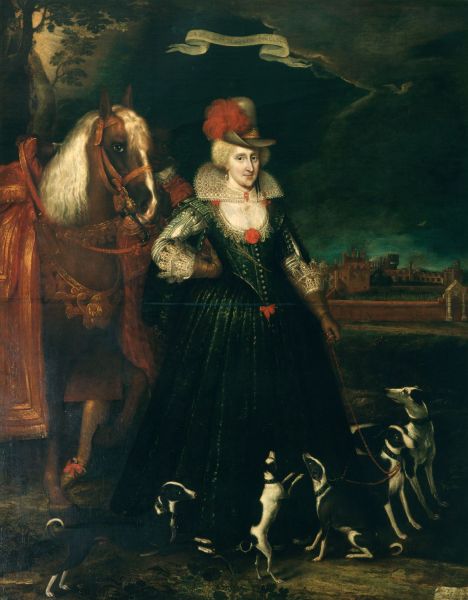
Betrayed Queen No 1: Anne of Denmark, wife of James VI of Scotland and I of England, by Paul van Somer, 1617. Image: Wikipedia.
She is shown wearing a fashionable riding habit, accompanied by her greyhounds, standing in front of Oatlands Palace, for which she had ordered Inigo Jones to build a new ornamental gateway. Jones’ beautiful Queen’s House at Greenwich was built for her, but was uncompleted at the time she died in 1619.
Anne was a cultured woman in a difficult marriage to a gay, frequently drunk, pedant. She enjoyed hunting and dancing. Her patronage of the arts, especially court masque and neoclassical architecture, added lustre and prestige to the disreputable, faction-ridden Jacobean court that lurched from plot to counter-plot while James deluded himself that a king with bishops could keep the balance of power.
She was lucky that Inigo Jones, an architect and designer of genius, was at hand to make her dream houses real and make theatre sets like dreams. She suffered depression and bad health for the last seven years of her life after the catacylismic death of her eldest son, Prince Henry in 1612.
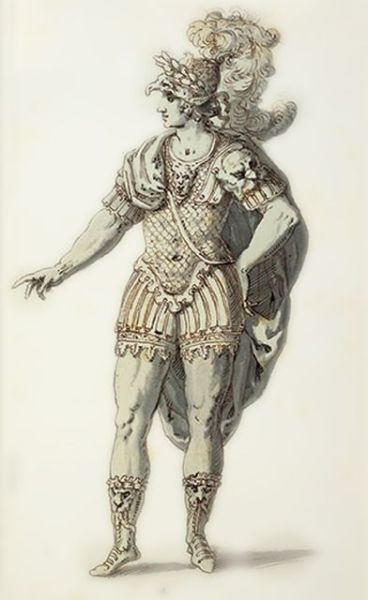
Design for a masque costume for Prince Henry in Oberon, the Faery Prince, 1611, by Inigo Jones.
Lost Prince: one of the might-have-beens of history, Charles I’s elder brother, the precocious, athletic and staunchly Protestant, Henry Frederick Stuart, who died of typhoid aged eighteen. Among other manly virtues, he understood the propaganda value of masque.
Anne might have been a secret Catholic, like her grandson Charles II (the most disillusioned and guileful of all the Stuarts and their courtiers) at a time when the political majority supported a Protestant succession to protect vested interests in the name of national security.
One of the ladies-in-waiting who accompanied the queen from Scotland to England in 1603, was Jean Ker, Countess of Roxburghe who became a spy for the Spanish government. Anne knew she could not be trusted, and managed to dismiss her in 1617.
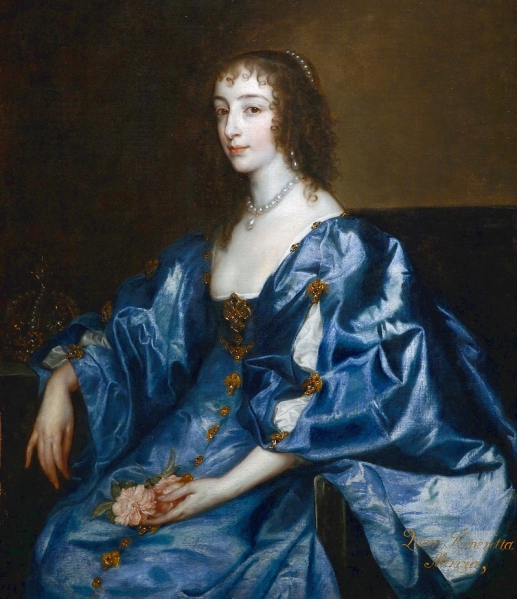
Betrayed Queen No 2: Henrietta Maria of France, wife and “Dear Heart” of Charles I, who was lucky enough to be painted by Van Dyck, the greatest propagandist the British Royal Family have ever had.
Oil painting, c. 1636 – 38. Image: Wikipedia
Van Dyck in his portraits and Inigo Jones in his theatrical designs transformed Henrietta Maria into a fairy tale queen of sweet dignity peeping out from billowing clouds of coloured silk.
Henrietta Maria, like her mother-in-law and husband, had a genuine enthusiasm for the arts. Like Anne, she enjoyed performing an active part in court masques.
Unlike Anne, she was also politically active and one of her husbands’s most influential advisers. He became increasingly dependent on her after the death of the Duke of Buckingham. Her devout Roman Catholicism aroused suspicion and unpopularity in the country during rising tensions between King and Parliament.
In February, 1642, she travelled to the Netherlands, ostensibly to reunite her nine year old daughter Mary with the princess’s husband, the Prince of Orange, when some of the ships in her fleet were wrecked by storms off the Dutch coast, and her ladies in waiting lost their wardrobes in the North Sea.
Of far more concern to the queen, the crown jewels and plate, which she had brought with her in the hope of selling to raise money for the royalist cause, were safe and dry.
Prominent in the royal entourage was Princess Mary’s governess, the Countess of Roxburghe.
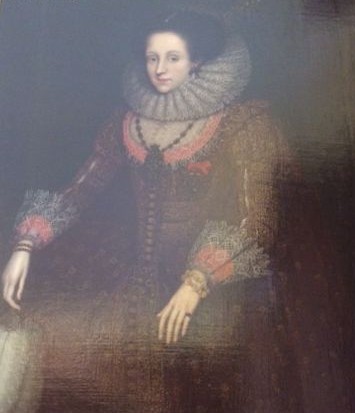
Betrayer: Jean Ker, Countess of Roxburghe, (c 1585 – 1643) lady-in-waiting to Queens Anne and Henrietta Maria successively, governess to three of the royal children, and spy for the Spanish government. Image: Adel in Nederland.
The activities of the dark lady were well known to the Jacobean and Caroline courts, where everyone was so used to spies, as one of the collateral evils hedging the king, that they just played along, feeding information when it suited them.
Lady Roxburghe had lost her position as Mistress of the Robes at Anne of Denmark’s court but was brought back into favour by Charles I, who appointed her governess to Princess Mary in 1631, and consequently to two of his younger children, a sign of his strong sympathy towards the Catholic faith.
She accompanied the princess to Holland in February 1642. Her luxurious silk dress was one of the losses in the shipwreck of the royal fleet off the Dutch island of Texel.
Kept close to the heart of the royal family as she was, it is hard to know who was spying on whom.
In the Masque of Queens, everybody finds out eventually that they are taking part in an illusion.
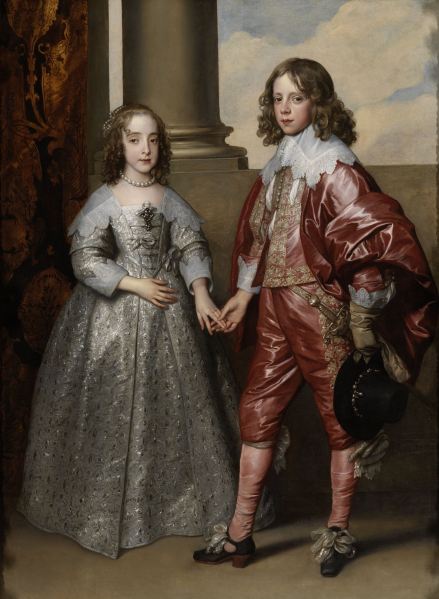
Dynastic Pawns: Princess Mary, eldest daughter of Charles I, and her husband Willem II, Prince of Orange, in one of Van Dyck’s most poignant portraits, painted in 1641 when the children (she was nine; he was fifteen) were formally married in London.
Image: Wikipedia
Thirty-six years later, during the Restoration, their only child, Willem III of Orange, married his cousin Mary Stuart, and they eventually succeeded to the English throne in the Protestant coup d’etat of 1688 as William III and Mary II.
The Stuart Masque was over. Continue reading
“Context is everything.”
(Peter Drucker, business management consultant, social ecologist and “the man who invented management” in the modern era of complexity, according to Business Week of which I’m not a regular reader.)
This blog advocates frivolity, and revels in images, especially of dead queens, at the same time it sniffs at celebrity photos, selfies and Hello! wedding photos.
So here it presents, in full consciousness of double standards, a stupendous piece of self-advertizing by a grandiose, self-made English politician, and patron of the arts, who hired one of the most gifted court propagandists of any age, Van Dyck, to sell his materially advantageous marriage to a higher-born aristocrat, the daughter of an earl, as a divine union featuring groom and bride half-naked, flaunting everything except their genitalia.

Anthony van Dyck Sir George Villiers and Lady Katherine Manners as Adonis and Venus c. 1620. Oil on canvas Private collection. Image WGA
The curly-haired hunk was the King’s favourite (a multi-nuanced term in this case because the king, a neurotic intellectual who’d had a seriously dysfunctional childhood, was gay and vulnerable to handsome, unscrupulous young men who played him along in exchange for office and titles), and chief minister, George Villiers, later created Duke of Buckingham.
He was the most powerful man in the kingdom during two reigns until his assassination eight years after this portrait was painted, and was later immortalized as a guest star of The Three Musketeers.
In real life, James’ son, Charles I, was as emotionally and politically dependent on Buckingham as his father had been. Intuitively serving two masters in different ways, Buckingham was their homme fatale, fulfilling their personal needs while alienating the nations they governed, a gorgeous psychological prop and political liability.
Portrayed in Van Dyck’s allegory when he was twenty-eight, he plays his amorous part to perfection, enjoying the adoration of his hound and his blue drapery being wafted by zephyrs while he ogles his prey, but Lady Katherine looks coy, even startled, about her classical role, as if she’d rather be fully dressed at a jolly lunch party than sporting with pagan gods, all for the sake of her husband proving to the world that she wasn’t his beard.
“I made this [letter] very long, because I did not have the leisure to make it shorter.”
(Je n’ai fait celle-ci plus longue que parce que je n’ai pas eu le loisir de la faire plus courte.)
Blaise Pascal, apologizing to his correspondents in Letter XVI, Provincial Letters, 1656.

Metsu, Man Writing a Letter 1662-65 Oil on panel. National Gallery of Ireland, Dublin. Image: WGA
Surfing the net for versions of this quote, you come across English criticism of Pascal for not making his aphorism shorter. Translators improved on the original, which is spread in stately baroque fashion over two sentences, into variants of:
If I had more time, I would have written a shorter letter
This is pithier and therefore sounds wittier to English ears. It omits the rich caress of the word “loisir”and the grace notes of irony and politesse. Maybe the literal translation should only be said with a French shrug to make the rest of us appreciate its élan.
Pascal was not writing an Oscar Wilde play; les lettres provinciales are not a bourgeois comedy of manners. Pascal was engaged in intellectual battle with the powerful Jesuits, laying waste to their methods of ethical reasoning with impregnable arguments of his own.
Brevity is the soul of wit, but it is very difficult to be truthful, and fair to your casuistic opponent, in a few words.
No-one likes receiving a letter of complaint, of any length, and finding the time to read it is a chore.
It is easy to write a short love letter, which the recipient would be happy to find leisure to read again and again. Anyone looking at them would think they were wasting time:

Metsu, Woman Reading a Letter 1662-65 Oil on panel. National Gallery of Ireland, Dublin. Image: WGA
Some letters are too personally important to be read in front of witnesses; their content penetrates your mind so deeply that you feel your axis shift. The minutes you spent physically reading a letter like that are preserved in your mind for ever. You will never be quite the same again. Till this moment I never knew myself.
 Vermeer, Woman in Blue Reading a Letter 1663-4. Oil on canvas. Rijksmuseum Amsterdam. Image: WGA
Vermeer, Woman in Blue Reading a Letter 1663-4. Oil on canvas. Rijksmuseum Amsterdam. Image: WGA
While she reads her letter, time stands still. Vermeer painted the silent gaps in time.
“The blues are brewin” (sung by Billie Holiday)
Acedia is a form of depression that was identified by theologians of the early Christian Church with sloth, a spiritual fatigue caused by too much time to brood and day-dream, especially in monasteries and convents, where self-discipline and self-motivation were essential for mental health.
At least one blogger is feeling the same symptoms today.
In the early 5th century, the ascetic and mystic John Cassian described acedia as “weariness or distress of the heart…akin to dejection”. Some of his suggested cures were manual work, sympathizing and caring for other people with loving kindness, taking plenty of exercise.
Later, in secular society, the same feelings of boredom and hopelessness were caused by the dull repetition of tasks at work or at home, whichever you were chained to, and by excessive pleasures and luxury of choice among the leisured classes.
More recently, acedia has been linked to the rise of consumerism in the 20th century. I’d add the Lottery, and the misuse of the word “aspiration” to dress up acquisitiveness in angel’s clothing. Modern shopping for stuff isn’t quite what the socialist arts leaders had in mind when they called for cultural beauty to be accessible and affordable to all of us.
Acedia is a sickly leveller, affecting rich and poor, the haves and the have-nots.